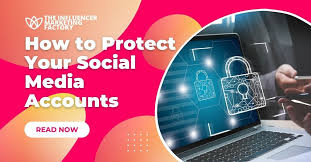Social media has become a vital part of our daily lives. From connecting with friends to building businesses, platforms like Facebook, Instagram, Twitter (X), TikTok, and LinkedIn hold massive amounts of personal and professional information. Unfortunately, they are also prime targets for cybercriminals. Every year, millions of people fall victim to account hacks, identity theft, and scams.
The good news? With the right strategies, you can protect your social media accounts and safeguard your digital presence.
1. Use Strong and Unique Passwords
One of the biggest mistakes people make is reusing the same password across multiple accounts. If one account is hacked, the rest become vulnerable.
Instead:
Use long, complex passwords with a mix of letters, numbers, and symbols.
Avoid personal details like your name, birthday, or phone number.
Consider using a password manager to generate and store secure passwords.
2. Enable Two-Factor Authentication (2FA)
Two-factor authentication adds an extra layer of security by requiring a second form of verification, such as a code sent to your phone or an authentication app. Even if someone gets your password, they won’t be able to access your account without this second step.
Most major platforms—including Facebook, Instagram, and Twitter—now support 2FA. Activating it should be one of your top priorities.
3. Watch Out for Phishing Scams
Phishing attacks remain one of the most common ways hackers steal social media credentials. You may receive an email, message, or link pretending to be from your social platform, asking you to log in or reset your password.
Tips to stay safe:
Never click on suspicious links.
Always check the official domain name before entering your details.
If in doubt, go directly to the platform’s app or website instead of following links.
4. Review Privacy Settings
Every social media platform has privacy settings that allow you to control who can see your posts, personal details, and contact information.
On Facebook, adjust your settings so only friends (not the public) can see sensitive information.
On Instagram, consider switching to a private account if you don’t need a public profile.
Limit the amount of personal information you share to reduce your risk of identity theft.
5. Be Careful with Third-Party Apps
Many hacks happen when people grant access to third-party apps, such as games or quizzes, that ask for unnecessary permissions.
Before allowing access:
Check if the app is trustworthy.
Avoid apps that request full access to your profile, messages, or contacts.
Regularly review and remove old or suspicious apps connected to your accounts.
6. Log Out on Shared Devices
If you log into your social accounts on a public or shared computer (such as in a cybercafé, library, or friend’s device), make sure to log out completely.
Better yet, avoid logging in on public devices altogether. Hackers can install keyloggers to steal your login information.
7. Stay Updated with Security Alerts
Social platforms often notify you of unusual login attempts or new device logins. Don’t ignore these alerts. If you see a suspicious login, immediately:
Change your password
Review your account activity
Enable 2FA (if not already active)
Conclusion
Protecting your social media accounts is not just about avoiding hacks—it’s about protecting your identity, reputation, and personal information. By using strong passwords, enabling two-factor authentication, avoiding phishing scams, and being mindful of your privacy settings, you can greatly reduce your chances of becoming a victim.
Remember: cybercriminals are always looking for easy targets. Don’t make it easy for them. Take proactive steps today to secure your digital life.
⚡ Key Takeaway: Your social media accounts hold valuable personal data—protect them with strong passwords, 2FA, and smart security habits.



